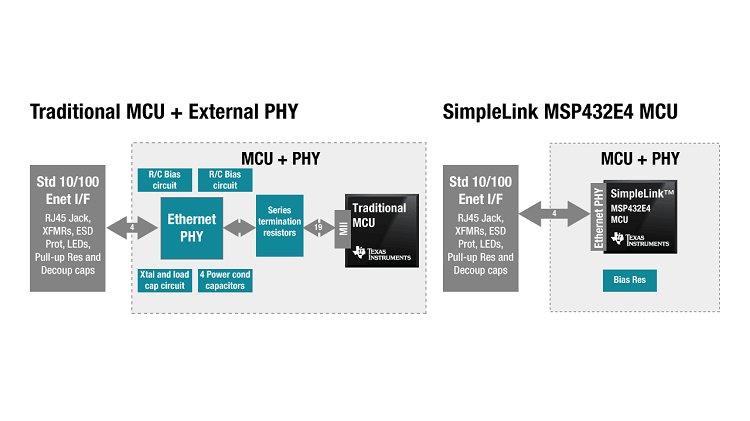By Richard Quinnell, editor-in-chief
The most common image for the Internet of Things (IoT) is that of a wirelessly connected device. But that approach either requires that the device support Wi-Fi or there be a gateway hub involved. The first option is a power burden on the IoT device, and the second option can add significantly to the developer’s design burden. Texas Instruments has relieved that second design burden with its latest release in its SimpleLink portfolio — the SimpleLink MSP432E4 Ethernet MCU.

Creating an IoT device requires developers to make a number of strategic decisions up front involving the system’s cloud element and how to connect with it. Many connectivity options exist, including Wi-Fi, Bluetooth to a mobile device, and the use of a hub gateway. But Wi-Fi is a bit of a power hog for IoT devices, and requiring a mobile device’s involvement is not always practical. The third option potentially gives designers a wide range of wireless choices that support power-optimized device design but at an added design cost. Either the developer must adhere to the protocol and radio requirements of an existing hub gateway approach or design a custom hub gateway to go along with their device.
Neither choice for the hub approach is optimal. Embracing an existing hub gateway approach typically involves the added cost of licensing and compatibility certification while limiting the device’s operation to that particular hub gateway’s power, bandwidth, and protocol tradeoffs. A custom hub gateway, on the other hand, requires its own development effort in parallel with the device’s design, typically involving completely different processors and software.
The Texas Instruments SimpleLink Ethernet MCU seeks to reduce the burden of creating a custom hub to go with an IoT device. As a member of the SimpleLink family, which already includes wireless MCUs for sub-GHz, Wi-Fi, and Bluetooth connectivity, the Ethernet MCU is fully software-compatible with other family members, all of which can use the same SDK as well as code plugins that help abstract connectivity options. This means that developers can reuse the code base developed for the IoT device when developing the hub, simplifying both the design effort and the integration effort when getting the hub and device to talk.
The SimpleLink Ethernet MCU has both the MAC and PHY layers for Ethernet built in to help lower the hub’s size and cost as well as simplify design. It also offers CAN and USB interfaces, and four SSI/SPI, 10 I2C, and eight UART ports for connecting to sensors and SimpleLink wireless MCUs for device connectivity of up to 50 end nodes. A memory expansion port supports the addition of even more nodes. With its built-in crypto acceleration, the MCU is able to maintain secure connections to both the devices and the cloud.
TI offers full developer support for the new MCU, including SimpleLink Academy training videos. A LaunchPad development kit is also available through the TI store for under $20.
Advertisement
Learn more about Electronic Products Magazine





